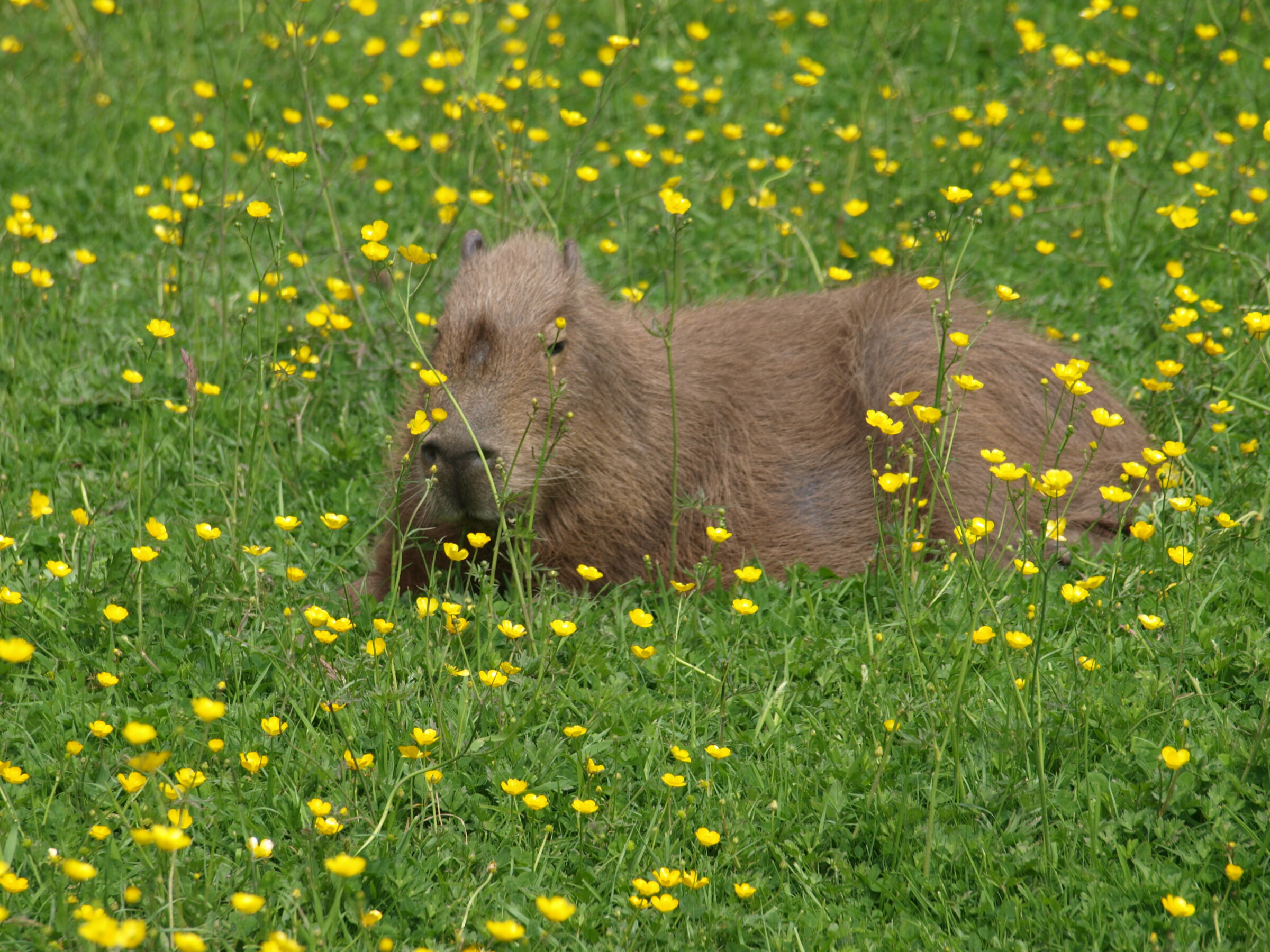This web page was produced as an assignment for an undergraduate course at Davidson College.

The sequenced genome of the capybara shows how they compensate for the drawbacks of gigantism including mechanisms for cancer suppression.
Capybaras, Hydrochoerus hydrochaeris, are the largest rodents currently in existences. They weigh around 55kg, about 60 times larger than their closest living relatives the rock cavies. Their massive size relative to their rodent relatives makes capybaras a source of interest to scientists. Gigantism is thought to come with several trade-offs. The first being that larger species tend to have relatively low population sizes which allows for less purifying selection to purge deleterious mutations. This causes a higher mutation load on the species which increases risk of extinction (Lynch and Gabriel 1990). The second major trade off is that a larger body size is achieved by having a larger amount of cells and if each cell has the same potential to develop into cancer then having more cells leads to higher rates of cancer. However despite these trade-offs there are several examples of thriving gigantic species such as elephants and whales. These species also don’t appear to experience higher rates of cancer either. This lack of correlation between cancer and size is referred to as Peto’s paradox (Caulin and Maley 2011) .
The capybara is a good study subject to investigate the tradeoffs and contradictions associated with gigantism because they are part of the diverse and well-studied order of rodents, allowing for convenient controls and comparisons. They are also slightly easier test subjects to sample than say, blue whales. Researchers took a genomic approach to using capybaras to study gigantism. The capybara genome was sequenced for the first time and analyzed for mechanisms that both allow for gigantism and compensate for some of its drawbacks.
The sequenced genome of the capybara was initially analyzed for phylogeny by comparing it with other rodent relatives. The capybara genome was comparable in size to similar species such as the guinea pig. They also found evidence of an increased rate of growth in the ancestor of the modern capybara. This increased growth rate has also been found in other gigantic species indicating potential parallels between the mechanisms for gigantism in capybaras and in other species. The mutation load of capybaras was estimated by comparing the rate of synonymous mutations or mutations that don’t affect protein creation with non-synonymous mutations. A higher ratio of non-synonymous to synonymous mutations could indicate a higher mutation load. This ratio was higher for capybaras than for other rodents however this was due to a lesser amount of synonymous mutation rather than a greater amount of non-synonymous mutations. This can be attributed to a generation time effect in which longer generations leads to a slower rate of mutation.
Investigation into the root genetic causes of gigantism in capybara yielded results showing the positive selection and expansion of genes involved in the insulin/insulin-like growth factor signaling (IIS) and transforming growth factor-β signaling (TGFβS). The IIS pathway is associated with cellular growth and spread during both the embryonic and post natal stage. The TGFβS pathways is associated with cell differentiation and is important for the development of bones and limbs. Cancer suppressing gene families were also found to be expanded and selected for. Theses families were TPT1 (tumor protein, translationally-controlled 1) a gene that allows for the reprogramming of cancerous cells, MAGEB5 (melanoma antigen family B5) which helps to activate the immune response to cancer, and GZMB (granzyme B) which allows immune cells to kill cancer cells. The changes found in these gene families provide a resolution to Peto’s Paradox and give a reason for the low rates of cancer in capybaras.
This research answers some of the questions about gigantism. We can see that the capybara’s longer generations slow evolution and reduced the mutation load of the species. There are also several genes of interest that have been shown to be associated with gigantism and cancer suppression in capybara. Further studies will need to conducted to determine whether other large species use similar genetic mechanisms for gigantism or if there are other potential genetic pathways towards gigantism. The cancer suppression mutations in capybara can also be further investigated. Understanding how capybara prevent cancer has the potential to lead to new cancer treatments that could be administered to human patients.
References
Caulin, A. F., and Maley, C. C. 2011. Peto’s Paradox: evolution’s prescription for cancer prevention. Trends in ecology & evolution, 26(4), 175–182. https://doi.org/10.1016/j.tree.2011.01.002
Lynch, M., and Gabriel, W. 1990. MUTATION LOAD AND THE SURVIVAL OF SMALL POPULATIONS. Evolution; international journal of organic evolution, 44(7), 1725–1737. https://doi.org/10.1111/j.1558-5646.1990.tb05244.x
Schmeeve. 2006. Capybara [Photo]. https://www.flickr.com/photos/schmeeve/299846093/
Swales, N. 2016. Chester Zoo [Photo]. https://www.flickr.com/photos/zooeurope/32549139924/
© Copyright 2020 Department of Biology, Davidson College, Davidson, NC 28036.
